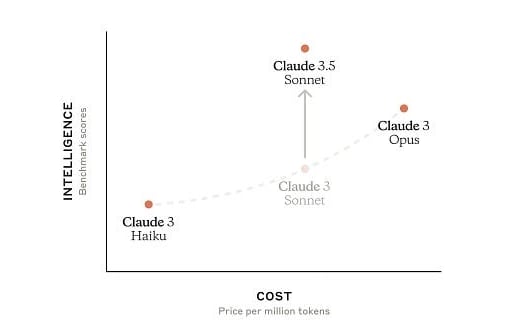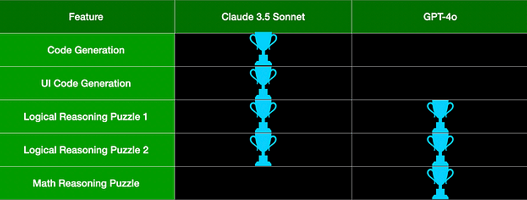Claude 3.5 Sonnet vs GPT-4o


Artificial Intelligence has made tremendous strides in recent years, with various models offering unique capabilities and features. Among the latest advancements are Claude 3.5 Sonnet and GPT-4, two powerful AI models that have garnered significant attention. This blog aims to provide a comprehensive review of these models, comparing their strengths, weaknesses, and overall performance to help you understand which one might be best suited for your needs.
Claude 3.5 Sonnet
Claude 3.5 Sonnet, developed by Anthropic, represents a significant leap in AI technology. Known for its emphasis on safety and ethical AI usage, Anthropic has designed Claude 3.5 Sonnet to be both powerful and responsible. This model is particularly noted for its natural language understanding, contextual awareness, and conversational abilities.


GPT-4o
GPT-4's performance is marked by its versatility and robustness across various domains. It handles complex queries with ease, providing detailed and accurate responses. GPT-4's architecture allows it to scale efficiently, making it suitable for large-scale applications. In competitive benchmarks, GPT-4o consistently ranks among the top models for accuracy and speed.
Language Understanding and Generation
Claude 3.5 Sonnet
Claude 3.5 Sonnet's strength lies in its ability to generate human-like text with a strong emphasis on maintaining ethical standards. It excels in tasks that require empathy and understanding, such as mental health support and educational tutoring. The model's conversational abilities are particularly notable, making interactions feel natural and engaging.
GPT-4o
GPT-4o boasts impressive language generation capabilities, producing coherent and contextually relevant text across a wide range of topics. Its advanced training dataset enables it to understand and generate text with remarkable fluency. GPT-4o is highly adaptable, performing well in creative writing, technical documentation, and interactive storytelling.
Ethical Considerations and Safety
Claude 3.5 Sonnet
Ethical AI is a cornerstone of Claude 3.5 Sonnet's design. Anthropic has implemented rigorous safety measures to ensure that the model generates content that is free from harmful biases and misinformation. This focus on ethical considerations makes Claude 3.5 Sonnet a reliable choice for applications where safety and trust are paramount.
GPT-4o
OpenAI has also prioritized ethical AI development with GPT-4, implementing safeguards to minimize the risk of harmful outputs. However, given its broader application range, GPT-4 faces more challenges in ensuring ethical usage. Continuous updates and community feedback are essential to maintaining its ethical standards.
Usability and Integration
Claude 3.5 Sonnet
Claude 3.5 Sonnet is designed with user-friendliness in mind. Its integration process is straightforward, with comprehensive documentation and support provided by Anthropic. The model's API is intuitive, making it accessible to developers with varying levels of expertise. Additionally, Claude 3.5 Sonnet's focus on ethical AI makes it particularly appealing to organizations prioritizing responsible AI deployment.
GPT-4o
GPT-4o offers extensive integration options, supported by OpenAI's robust API infrastructure. Its versatility allows it to be implemented in diverse environments, from small startups to large enterprises. OpenAI provides detailed documentation and community support, ensuring that developers can effectively leverage GPT-4's capabilities.
Cost and Accessibility Claude 3.5 Sonnet
Anthropic has positioned Claude 3.5 Sonnet as a premium AI solution, reflecting its advanced capabilities and ethical focus. While this might make it less accessible to smaller organizations, the investment can be justified by its performance and ethical reliability. Pricing details are tailored to specific use cases, ensuring that clients receive a solution that meets their needs.
GPT-4o
GPT-4's pricing model is designed to be flexible, accommodating a wide range of users from individual developers to large corporations. OpenAI offers various tiers of access, making GPT-4o more accessible to a broader audience. This flexibility ensures that users can choose a plan that aligns with their budget and usage requirements.
Conclusion
In the rapidly evolving landscape of AI, both Claude 3.5 Sonnet and GPT-4o stand out as exceptional models, each with its own set of strengths. Claude 3.5 Sonnet excels in ethical considerations and natural language understanding, making it a reliable choice for applications where safety and empathy are crucial. On the other hand, GPT-4o offers unparalleled versatility and performance, suitable for a wide range of tasks and industries.
Choosing between these two models depends on your specific needs and priorities. If ethical AI and conversational quality are paramount, Claude 3.5 Sonnet is a compelling choice. However, if you require a versatile and powerful AI capable of handling diverse tasks, GPT-4o is likely the better option.
By understanding the unique attributes of Claude 3.5 Sonnet and GPT-4o, you can make an informed decision that aligns with your goals and requirements. As AI technology continues to advance, these models will undoubtedly play a significant role in shaping the future of intelligent systems.
Technical Details
Claude 3.5 Sonnet
Architecture: Transformer-based
Training Data: Emphasis on ethical and safe content
Key Features: Contextual awareness, ethical generation, conversational AI
Applications: Customer support, mental health support, educational tools
GPT-4o
Architecture: Transformer-based
Training Data: Diverse and extensive dataset
Key Features: Versatility, scalability, advanced language generation
Applications: Text generation, technical documentation, creative writing
Future Prospects
As AI models continue to evolve, both Anthropic and OpenAI are expected to introduce further enhancements and iterations. The focus on ethical AI development will likely remain a priority, addressing concerns about bias and misinformation. Additionally, advancements in AI architecture and training methodologies will contribute to even more capable and reliable models in the future.


